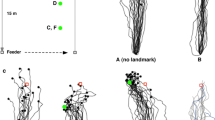Abstract
A model is developed by which path integration as observed in many animal species could be implemented neurobiologically. The proposed architecture is able to describe the navigation behaviour of Cataglyphis ants, and that of other social insects, at the level of interacting neurons. The basic idea of this architecture is the concept of activity patterns travelling along neural chains. Although experimental evidence has yet to be provided, this concept seems biologically plausible and not limited to the navigation problem. Neural chains are able to represent variables by activity patterns with high accuracy and temporal stability. Moreover, they are able to integrate incremental signals with high precision. Cyclical chains of neurons show superior performance as soon as cyclical variables are to be represented and integrated. Finally, representation of cyclical variables by travelling activity peaks allows simple approximations of goniometric functions as they are used in path integration systems.
Similar content being viewed by others
References
Benhamou S, Sauve JP, Bovet P (1990) Spatial memory in large-scale movements: efficiency and limitation of the egocentric coding process. J Theor Biol 145:1–12
Bisetzky AR (1957) Die Tänze der Bienen nach einem Fussweg zum Futterplatz. Z Vergl Physiol 40:264–288
Collett TS, Dillmann E, Giger A, Wehner R (1992) Visual landmarks and route following in desert ants. J Comp Physiol [A] 170: 435–442
Eckmiller R (1987) Computational model of the motor program generator for pursuit. J Neurosci Methods 21:127–138
French AS, Stein RB (1970) A flexible neural analog using integrated circuits. IEEE Trans Biomed Eng 17:248–253
Gallistel CR (1990) The organization of learning. MIT Press, Cambridge, Mass
Görner P (1958) Die optische und kinästhetische Orientierung der Trichterspinne Agelena labyrinthica. Z Vergl Physiol 41:111–153
Görner P, Claas B (1985) Homing behaviour and orientation in the funnel-web spider, Agelena labyrinthica. In: Barth FG (eds) Neurobiology of arachnids. Springer, Berlin Heidelberg New York, pp 275–297
Gould JL (1986) The locale map of honey bees: do insects have cognitive maps? Science 232:861–863
Hartmann G (1992) Motion induced transformations of spatial representations: mapping 3D information onto 2D. Neural Networks 5:823–834
Jander R (1957) Die optische Richtungsorientierung der Roten Waldameise (Formica Rufa). Z Vergl Physiol 40:162–238
Lindauer M (1963) Kompassorientierung. Ergeh Biol 26:158–181
Michel B, Wehner R (1995) Phase-specific activation of landmark memories during homeward-bound vector navigation in desert ants, Cataglyphis fortis. Proc Neurobiol Conf Göttingen 23(1):41
Mittelstaedt H (1962) Control systems of orientation in insects. Annu Rev Entomol 7:177–198
Mittelstaedt H (1985) Analytical cybernetics of spider navigation. In: Barth FG (eds) Neurobiology of arachnids. Springer, Berlin Heidelberg New York, pp 298–316
Mittelstaedt ML, Mittelstaedt H (1973) Mechanismen der Orientierung ohne richtende Aussenreize. Fortschr Zool 21:46–58
Mittelstaedt ML, Mittelstaedt H (1980) Homing by path integration in a mammal. Naturwissenschaften 67:566
Müller M (1989) Mechanismus der Wegintegration bei Cataglyphis fortis (Hymenoptera, Insecta). PhD thesis, University of Zürich
Müller M, Wehner R (1988) Path integration in desert ants, Cataglyphis fortis. Proc Natl Acad Sci USA 85:5287–5290
O'Keefe J (1991) An allocentric spatial model for the hippocampal cognitive map. Hippocampus 1(3): 230–235
Ronacher B, Manetsch D, Wehner R (1994) Self-induced optic flow cues influence the assessment of travel distance in the ant Cataglyphis fortis
Ronacher B, Wehner R (1995) Desert ants Cataglyphis fortis use selfinduced optic flow to measure distances travelled. J Comp Physiol A 177:21–27
Saint-Paul Uv (1982) Do geese use path integration for walking home? In: Papi F, Walraff HG (eds) Avian navigation. Springer, Berlin Heidelberg New York, pp 298–307
Sauve JP (1989) L'orientation spatiale: formalisation d'un modèle de mémorisation égocentrée et expérimentation chez l'homme. PhD thesis, University of Aix-Marseille
Schäfer M, Wehner R (1993) Loading does not affect measurement of walking distance in desert ants, Cataglyphisfortis. Verh Dtsch Zool Ges 86:270
Seguinot V, Maurer R, Etienne AS (1993) Dead reckoning in a small mammal: the evaluation of distance. J Comp Physiol [A] 173:103–113
Seyfarth EA, Hergenröder R, Ebbes H, Barth FG (1982) Idiothetic orientation of a wandering spider: compensation of detours and estimates of goal distance. Behav Ecol Sociobiol 11:139–148
Touretzki T (1993) Neural representation of space using sinusoidal arrays. Neural Comput 5:869–884
Visscher PK, Seeley TD (1982) Foraging strategy of honeybee colonies in a temperate deciduous forest. Ecology 63:1790–1801
Wehner R (1981) Spatial vision in arthropods. In: Autrum H (eds) Handbook of sensory physiology, vol. VII/6c. Springer, Berlin Heidelberg New York, pp 287–616
Wehner R (1982) Himmelsnavigation bei Insekten. Neurophysiologie und Verhalten. Neujahrsbl Naturforsch Ges Zürich 184:1–132
Wehner R (1987a) Spatial organization of foraging behavior in individually searching desert ants, Cataglyphis (Sahara Desert) and Ocymyrmex (Namib Desert). In: Pasteels JM, Deneubourg J-L (eds) From individual to collective behavior in social insects. Birkhäuser, Basel, pp 15–42
Wehner R (1987b) Matched filters': neural models of the external world. J Comp Physiol [A] 161:511–531
Wehner R (1992) Arthropods. In: Papi F (eds) Animal Homing. Chapman and Hall, London, pp 45–144
Wehner R (1994) The polarization-vision project: championing organismic biology. In: Schildberger K, Elsner N (eds) Neural basis of behavioural adaptation. G Fischer, Stuttgart, pp 103–143
Wehner R, Harkness RD, Schmid-Hempel P (1983) Foraging strategies in individually searching ants, Cataglyphis bicolor (Hymenoptera: Formicidae). Akad Wiss Lit Mainz, Math Naturwiss Kl. Fischer, Stuttgart
Wehner R, Menzel R (1990) Do insects have cognitive maps? Annu Rev Neurosci 13:403–414
Wehner R, Srinivasan MV (1981) Searching behaviour of desert ants, genus Cataglyphis (Formicidae, Hymenoptera). J Comp Physiol 142:315–338
Wehner R, Wehner S (1986) Path integration in desert ants: approaching a long standing puzzle in insect navigation. Monitore Zool Ital NS) 20:309–331
Wehner R, Wehner S (1990) Insect navigation: use of maps or Ariadne's thread? Ethol Ecol Evol 2:27–48
Wittmann T (1994) A neurobiologically plausible model of path integration. In: Proceedings of the 22nd Göttingen Neurobiology Conference, p 868
Author information
Authors and Affiliations
Rights and permissions
About this article
Cite this article
Hartmann, G., Wehner, R. The ant's path integration system: a neural architecture. Biol. Cybern. 73, 483–497 (1995). https://doi.org/10.1007/BF00199541
Received:
Accepted:
Issue Date:
DOI: https://doi.org/10.1007/BF00199541




